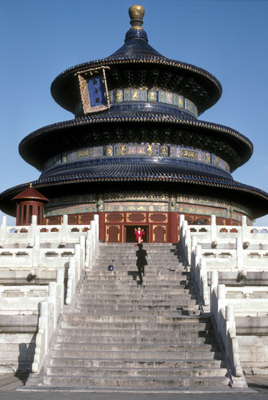 The physical geography of a location has significant implications for travel photography. The size of the area in which you intend to work is obviously significant but can be deceiving. Journey times in remote areas are determined by the nature of the terrain and roads, and hence the actual distance travelled. On a modern motorway one would reasonably expect to complete a fifty-mile car journey in no more than an hour. In Bhutan, where the roads are winding, a similar road journey might take three hours. Trains across South America's altiplano can be twelve hours late, and in India local services may average only 20 mph. When travelling by air, consider the local reputation for overbooking, flight cancellations and delays, and allow for stopover times, jet lag, changes of time zone and consequent tiredness.
The physical geography of a location has significant implications for travel photography. The size of the area in which you intend to work is obviously significant but can be deceiving. Journey times in remote areas are determined by the nature of the terrain and roads, and hence the actual distance travelled. On a modern motorway one would reasonably expect to complete a fifty-mile car journey in no more than an hour. In Bhutan, where the roads are winding, a similar road journey might take three hours. Trains across South America's altiplano can be twelve hours late, and in India local services may average only 20 mph. When travelling by air, consider the local reputation for overbooking, flight cancellations and delays, and allow for stopover times, jet lag, changes of time zone and consequent tiredness.
Altitude above sea level is also a significant consideration. If you reside close to sea level and are then whisked by jet to a location above 10,000 feet you are likely to feel at least some temporary effects of the reduced oxygen level. The height at which so-called altitude sickness becomes noticeable varies from person to person, but most feel the effects above 14,000 feet. Symptoms can be reduced or eliminated by allowing the body adequate time to acclimatise. Above about 12,000 feet it is better to limit daily increases in altitude to 2,000 feet. The often-quoted mantra "Go high, sleep low" is a valuable guide. Essentially it means that climbing from 10,000 to 15,000 feet during the day is acceptable provided a descent to 12,000 feet is made before sleeping. Above 14,000 feet rest days should be planned; that is, sleep two nights at the same altitude before sleeping higher. If you experience symptoms of acute mountain sickness (AMS) such as headaches, nausea, swelling of the body or loss of appetite you should not ascend further until they pass. If they persist or get worse you must descend. Ultraviolet radiation (UV) also becomes an increasing problem as you ascend. It burns sensitive skin even though the temperature may be below freezing, and makes the application of high-factor sun-cream essential. Radiation reflected upwards from sand or snow can also cause burning. UV filters fitted to lenses reduce the bluish cast in high-altitude mountain scenes.
The combined effects of latitude and season determine the number of hours of daylight in a particular location. The earth's axis of rotation is inclined at an angle of 66 degrees to the ecliptic, the plane of the planet's orbit around the sun. This gives us seasonal changes and annual variations in the hours of daylight. Close to the equator the sun rises at about 0600, passes more or less overhead at midday and sets at approximately 1800. At much higher latitudes the hours of daylight are significantly extended in summer and shortened in winter. In the tropics the path traced by the rising or setting sun is almost perpendicular to the horizon, so sunrise or sunset happens relatively quickly. As latitude increases the perceived path tends towards the horizontal, and sunrises and sunsets are extended. Within the Arctic and Antarctic circles the midsummer sun decreases in elevations, passes low along the horizon and then rises again, giving a period of 24-hour daylight. In winter a comparable period of total darkness occurs.
A final geographical consideration is related to the local terrain. Dry, dusty or desert environments are hard on photographic equipment. Beach environments are particularly harsh because of the abrasive nature of sand and the corrosive effects of salt. Sand or dust in cassette light seals will scratch an entire film. The slot canyons of the American southwest are hostile to cameras for similar reasons – grit falls constantly from the overhead canyon walls. It is therefore worth carrying plastic bags to protect valuable gear. When changing lenses, or opening a camera to change films, do so in a sheltered location with the vulnerable open parts of equipment directed away from sources of contamination. This is vitally important when changing lenses on digital cameras, as sensors are particularly sensitive to dust.